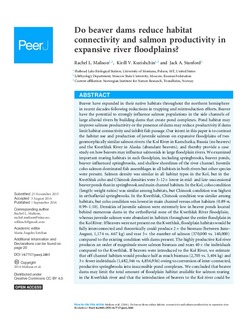Do beaver dams reduce habitat connectivity and salmon productivity in expansive river floodplains?
Journal article, Peer reviewed
Permanent lenke
http://hdl.handle.net/11250/2407556Utgivelsesdato
2016Metadata
Vis full innførselSamlinger
- Publikasjoner fra CRIStin - NINA [2364]
- Scientific publications [1392]
Sammendrag
Subjects Fisheries and Fish Science, Ecology
Alaska, Alluvial river floodplains, Kamchatka, North American beaver, Castor
canadensis, Pacific salmon, Salmon ecology, Salmon production Beaver have expanded in their native habitats throughout the northern hemisphere
in recent decades following reductions in trapping and reintroduction efforts. Beaver
have the potential to strongly influence salmon populations in the side channels of
large alluvial rivers by building dams that create pond complexes. Pond habitat may
improve salmon productivity or the presence of dams may reduce productivity if dams
limit habitat connectivity and inhibit fish passage. Our intent in this paper is to contrast
the habitat use and production of juvenile salmon on expansive floodplains of two
geomorphically similar salmon rivers: the Kol River in Kamchatka, Russia (no beavers)
and the Kwethluk River in Alaska (abundant beavers), and thereby provide a case
study on how beavers may influence salmonids in large floodplain rivers. We examined
important rearing habitats in each floodplain, including springbrooks, beaver ponds,
beaver-influenced springbrooks, and shallow shorelines of the river channel. Juvenile
coho salmon dominated fish assemblages in all habitats in both rivers but other species
were present. Salmon density was similar in all habitat types in the Kol, but in the
Kwethluk coho and Chinook densities were 3 12 lower in mid- and late-successional
beaver ponds than in springbrook and main channel habitats. In the Kol, coho condition
(length: weight ratios) was similar among habitats, but Chinook condition was highest
in orthofluvial springbrooks. In the Kwethluk, Chinook condition was similar among
habitats, but coho condition was lowest in main channel versus other habitats (0.89 vs.
0.99 1.10). Densities of juvenile salmon were extremely low in beaver ponds located
behind numerous dams in the orthofluvial zone of the Kwethluk River floodplain,
whereas juvenile salmon were abundant in habitats throughout the entire floodplain in
the Kol River. If beavers were not present on the Kwethluk, floodplain habitats would be
fully interconnected and theoretically could produce 2 the biomass (between June
August, 1,174 vs. 667 kg) and rear 3 the number of salmon (370,000 vs. 140,000)
compared to the existing condition with dams present. The highly productive Kol river
produces an order of magnitude more salmon biomass and rears 40 the individuals
compared to the Kwethluk. If beavers were introduced to the Kol River, we estimate
that off-channel habitats would produce half as much biomass (2,705 vs. 5,404 kg) and
3 fewer individuals (1,482,346 vs. 4,856,956) owing to conversion of inter-connected,
productive springbrooks into inaccessible pond complexes. We concluded that beaver
dams may limit the total amount of floodplain habitat available for salmon rearing
in the Kwethluk river and that the introduction of beavers to the Kol river could be
How to detrimental to salmon populations. The introduction of beavers to other large alluvial rivers like those found in Kamchatka could have negative consequences for salmon production.

